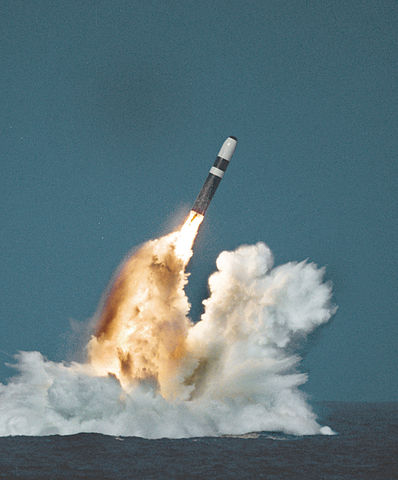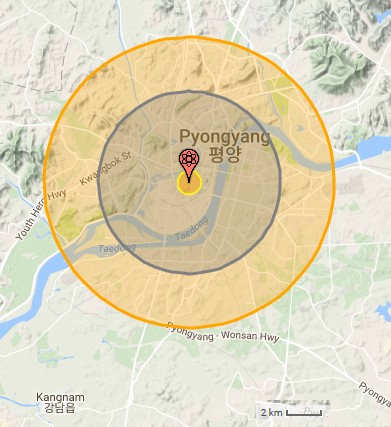aNewDomain — Pres. Donald Trump’s threat to “totally destroy North Korea” during his recent speech at the United Nations was grotesque, sure. But it wasn’t an empty one. When Trump told Secretary of State Rex Tillerson on Sunday that he was “wasting his time” in negotiating with North Korea, it could be taken as a sign that Trump is about to give the signal for a nuclear first strike on North Korea.
If just one of America’s 14 Ohio class submarines — say, the USS Alabama SSBN-731 — were assigned the task, the results would be devastating. Just one of the Alabama’s Trident II MIRV missiles carries a dozen W88 nuclear warheads. If targeted on North Korea’s 12 largest cities, one Trident II missile would kill about 2.5 million North Koreans and injure another 3.2 million.
That’s about 25 percent of the entire population of North Korea.

As for Trump, he really was just articulating a non-verbalized American policy for all US presidents for at least the past 40 years.
The Cold War has been over long enough that the anticipated horrors of nuclear war so common 30 years ago have been all but forgotten. Unlike our memories, though, nuclear weapons never went away. The US still has nearly 7,000 of them.
If the USS Alabama fired all of its Trident II D-5 ballistic missiles, the entire population of North Korea would be killed. Not injured. Dead.
That’s the destructive power of one US Ohio class ballistic missile submarine. The US has 14 Ohio class submarines. We don’t even need to talk about the other two prongs of the so-called American nuclear trident – missiles and bombers – to see how North Korea could be obliterated.
I selected the USS Alabama because this SSBN starred in the 1995 film Crimson Tide, which included a memorable speech by Gene Hackman as the sub’s captain that is not entirely inaccurate in describing the abilities of a US ballistic missile submarine – see the speech below.
Oh, at the moment, the USS Alabama also appears to be assigned to duty in the Pacific. So, if you wanted an SSBN to launch missiles at North Korea, the USS Alabama may well be in the right place.
The first Ohio class nuclear submarines were ordered during the Ford presidency and were launched during the Carter presidency. The Trident II missile was ordered during the Reagan presidency and entered service during the first Bush presidency. The W88 warhead was designed during the Nixon, Ford, and Carter presidencies.
The USS Alabama itself was ordered during the Carter presidency and entered service during the Reagan presidency.
There’s nothing new about the US having tremendous destructive capabilities. The US is thus far the only country to have ever used a nuclear weapon, and it’s used them twice. So, those 7,000 nuclear weapons are not a mere threat.
 Nuclear strategy with North Korea however is likely a bit different than a Cold War nuclear strategy. During the Cold War, it was assumed that the US might fire a small number of nuclear missiles to send a message that it was willing to launch more missiles. This strategy assumed that it might avoid a global nuclear war against an opponent that also held a huge stockpile of nuclear weapons.
Nuclear strategy with North Korea however is likely a bit different than a Cold War nuclear strategy. During the Cold War, it was assumed that the US might fire a small number of nuclear missiles to send a message that it was willing to launch more missiles. This strategy assumed that it might avoid a global nuclear war against an opponent that also held a huge stockpile of nuclear weapons.
Since North Korea has only a few nuclear weapons and since the North Korean government has rarely shown a capacity for compromise this conventional Cold War strategy might be perceived as unlikely to work.
If a nuclear “shot across the bow” is deigned unlikely to work, then a full scale first strike becomes thinkable to those who can order such a first strike. The destruction of North Korea’s largest cities would likely be just one part of the overall attack.
Other attacks would likely use smaller nuclear weapons to take out strategic facilities like the Punggye-ri Nuclear Test Site and various command and control centers. Conventional missiles and bombing missions would be used to attack North Koreas many entrenched rocket and artillery facilities. Special forces would likely be used to attack certain military targets and other facilities. A line of persistent chemical weapons might well be spread across the Demilitarized Zone to deter any North Korean attack.
US and South Korean troops already on the Korean peninsula might well not be placed on alert before the nuclear attack since such an alert would likely be detected by the North Koreans. After the North Korean nuclear attack, the nuclear fallout would likely not facilitate a military invasion for some period of time anyway. The attack on North Korea could be launched by US military assets outside of North Korea and outside North Korea’s ability to detect them.
Of course, the world would have a tremendous radioactive fallout problem to handle. To a cynical person this might amount to a tremendous public works project.
America’s global reputation would likely be in tatters after such a first strike. China and Russia seem unlikely to come to North Korea’s aid militarily. What’s the point in coming to the defense of scorched earth? But the unfolding public relations disaster would cause as much damage to the US as a war.
The Chinese likely don’t really care all that much for North Korea and the Kim family dynasty. The Chinese just don’t want US or South Korean troops on their border. The Russians probably feel just about the same. The US could propose that what was once North Korea become a United Nations protectorate for an extended period of time. The aftermath of this attack is going to require a tremendous humanitarian response, and the Korean War itself was, after all, a UN operation. So, UN intervention after the attack seems a natural fit.
It seems unlikely that Trump and his supporters would anticipate or even care really about what such a first strike would do to the image of the US as a force for global stability, especially since they pride themselves on insularity. They simply wouldn’t understand why their rationalizations for such a first strike would almost certainly fall on deaf ears globally.
No doubt a plan much like the one above has been formed. But let us hope it is never carried out.
The Korean War (1950-1953) caused a change in how US military planners viewed the conventional military. After the US used two nuclear weapons on Japan, military planners in the inner-war period thought that conventional forces could be drastically reduced if not eliminated entirely. They briefly believed that the only soldiers needed would be ones to deliver atomic bombs and other soldiers to protect the bombs.
The Korean War changed the thinking of military planners when it became clear that nuclear weapons couldn’t be used on the Korean peninsula because of the potential for retaliation by the Soviets, because the mission was sponsored by the United Nations, and because fighting in the conflict wasn’t really amenable to a nuclear solution anyway.
It’s just possible that the current debacle in North Korea may lead military planners almost full circle back to a conclusion that one of the more viable military solutions lies in the use of nuclear weapons – entirely the opposite of their thinking about Korea in the 1950s.
Of course, the hope among the military planners is that an ambitious North Korean general will take matters into his own hands, terminate the Kim dynasty and enter into discussions that will lower tensions. I suspect that the West might actually be amenable to North Korea having nuclear weapons provided they deployed them for strategic defensive purposes and not for nuclear terrorism.
The North Korean population database seems to underestimate the population for certain cities. But if you’d like to plan your own nuclear war, NukeMap could be just the ticket.
For aNewDomain, I’m Tom Ewing.
Cover image and inset map image: Tom Ewing for aNewDomain. Inset images: Department of Defense/US Navy, Public Domain.













